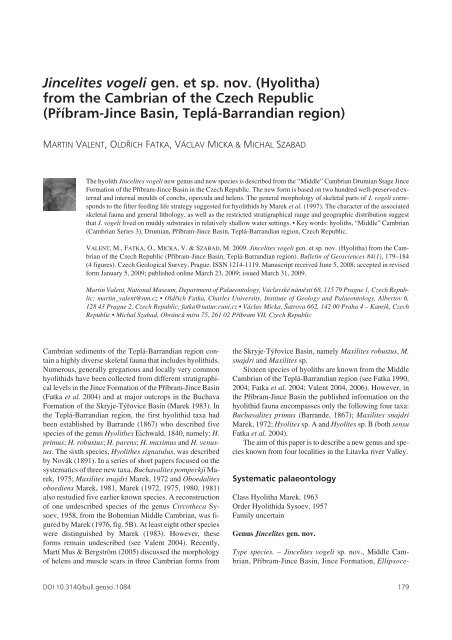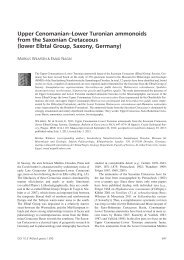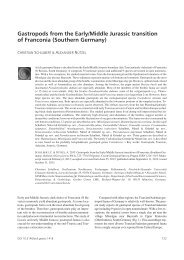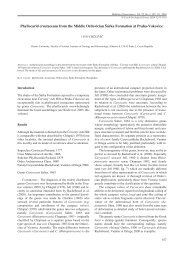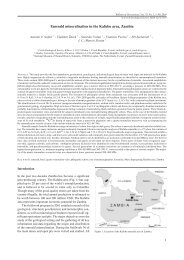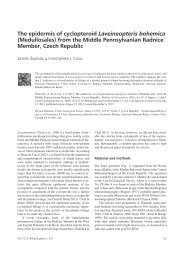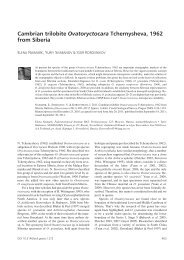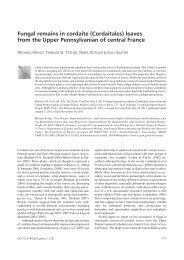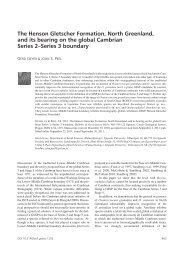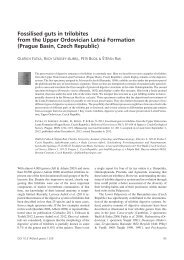download PDF (1.62 MB)
download PDF (1.62 MB)
download PDF (1.62 MB)
You also want an ePaper? Increase the reach of your titles
YUMPU automatically turns print PDFs into web optimized ePapers that Google loves.
The hyolith Jincelites vogeli new genus and new species is described from the “Middle” Cambrian Drumian Stage Jince<br />
Formation of the Příbram-Jince Basin in the Czech Republic. The new form is based on two hundred well-preserved external<br />
and internal moulds of conchs, opercula and helens. The general morphology of skeletal parts of J. vogeli corresponds<br />
to the filter feeding life strategy suggested for hyolithids by Marek et al. (1997). The character of the associated<br />
skeletal fauna and general lithology, as well as the restricted stratigraphical range and geographic distribution suggest<br />
that J. vogeli lived on muddy substrates in relatively shallow water settings. • Key words: hyoliths, “Middle” Cambrian<br />
(Cambrian Series 3), Drumian, Příbram-Jince Basin, Teplá-Barrandian region, Czech Republic.<br />
VALENT, M., FATKA, O., MICKA,V.&SZABAD, M. 2009. Jincelites vogeli gen. et sp. nov. (Hyolitha) from the Cambrian<br />
of the Czech Republic (Příbram-Jince Basin, Teplá-Barrandian region). Bulletin of Geosciences 84(1), 179–184<br />
(4 figures). Czech Geological Survey, Prague. ISSN 1214-1119. Manuscript received June 5, 2008; accepted in revised<br />
form January 5, 2009; published online March 23, 2009; issued March 31, 2009.<br />
Martin Valent, National Museum, Department of Palaeontology, Václavské náměstí 68, 115 79 Prague 1, Czech Republic;<br />
martin_valent@nm.cz • Oldřich Fatka, Charles University, Institute of Geology and Palaeontology, Albertov 6,<br />
128 43 Prague 2, Czech Republic; fatka@natur.cuni.cz • Václav Micka, Šatrova 662, 142 00 Praha 4 – Kamýk, Czech<br />
Republic • Michal Szabad, Obránců míru 75, 261 02 Příbram VII, Czech Republic<br />
Cambrian sediments of the Teplá-Barrandian region contain<br />
a highly diverse skeletal fauna that includes hyolithids.<br />
Numerous, generally gregarious and locally very common<br />
hyolithids have been collected from different stratigraphical<br />
levels in the Jince Formation of the Příbram-Jince Basin<br />
(Fatka et al. 2004) and at major outcrops in the Buchava<br />
Formation of the Skryje-Týřovice Basin (Marek 1983). In<br />
the Teplá-Barrandian region, the first hyolithid taxa had<br />
been established by Barrande (1867) who described five<br />
species of the genus Hyolithes Eichwald, 1840, namely: H.<br />
primus; H. robustus; H. parens; H. maximus and H. venustus.<br />
The sixth species, Hyolithes signatulus, was described<br />
by Novák (1891). In a series of short papers focused on the<br />
systematics of three new taxa, Buchavalites pompeckji Marek,<br />
1975; Maxilites snajdri Marek, 1972 and Oboedalites<br />
oboediens Marek, 1981, Marek (1972, 1975, 1980, 1981)<br />
also restudied five earlier known species. A reconstruction<br />
of one undescribed species of the genus Circotheca Sysoev,<br />
1958, from the Bohemian Middle Cambrian, was figured<br />
by Marek (1976, fig. 5B). At least eight other species<br />
were distinguished by Marek (1983). However, these<br />
forms remain undescribed (see Valent 2004). Recently,<br />
Martí Mus & Bergström (2005) discussed the morphology<br />
of helens and muscle scars in three Cambrian forms from<br />
the Skryje-Týřovice Basin, namely Maxilites robustus, M.<br />
snajdri and Maxilites sp.<br />
Sixteen species of hyoliths are known from the Middle<br />
Cambrian of the Teplá-Barrandian region (see Fatka 1990,<br />
2004; Fatka et al. 2004; Valent 2004, 2006). However, in<br />
the Příbram-Jince Basin the published information on the<br />
hyolithid fauna encompasses only the following four taxa:<br />
Buchavalites primus (Barrande, 1867); Maxilites snajdri<br />
Marek, 1972; Hyolites sp. A and Hyolites sp. B (both sensu<br />
Fatka et al. 2004).<br />
The aim of this paper is to describe a new genus and species<br />
known from four localities in the Litavka river Valley.<br />
<br />
Class Hyolitha Marek, 1963<br />
Order Hyolithida Sysoev, 1957<br />
Family uncertain<br />
Genus Jincelites gen. nov.<br />
Type species. – Jincelites vogeli sp. nov., Middle Cambrian,<br />
Příbram-Jince Basin, Jince Formation, Ellipsoce-
Simplified sketch map showing the location of fossil sites in<br />
the “Middle” Cambrian Jince Formation within the Příbram-Jince Basin,<br />
Central Bohemia. 1 – Vinice Hill near Jince, 2 – railway exposure at the<br />
Zelený mlýn Mill locality near Rejkovice, 3 – Koníček Hill locality,<br />
4 – Vystrkov Hill locality.<br />
phalus hoffi – Paradoxides (Rejkocephalus) –Lingulella<br />
Zone.<br />
Derivation of name. – After the town of Jince in the Litavka<br />
river Valley, Czech Republic.<br />
Diagnosis. – Hyolithid with small orthocone conch and<br />
short broadly rounded ligula. Conch rounded and triangular<br />
in cross-section with low keel developed on dorsum.<br />
Sculpture consists of only transverse elements. Monoclaviculate<br />
operculum with well developed broadly diverging<br />
clavicles and with straight adjacent narrow cardinal processes<br />
on the inner side. Outer side of operculum bears<br />
large conical shield and small cardinal shield; rooflets<br />
broad and well developed.<br />
Stratigraphical distribution of Jincelites vogeli sp. nov. within<br />
the Jince Formation of the Příbram-Jince Basin (biostratigraphy after<br />
Fatka & Szabad unpublished data). 1 – Vinice Hill near Jince, 2 – railway<br />
exposure at the Zelený mlýn Mill locality near Rejkovice, 3 – Koníček<br />
Hill locality, 4 – Vystrkov Hill locality.<br />
Discussion. – Jincelites resembles Carinolithes Sysoev,<br />
1958 (type species: Hyolithus pennatulus Holm, 1893 from<br />
the Upper Middle Cambrian Paradoxides forchhammeri<br />
Regional Stage of Sweden; cf. Berg-Madsen & Malinky<br />
1999) in the morphology of the dorsal keel. However, the<br />
keel is distinctly higher in Carinolithes. In addition, the genera<br />
differ in the basic morphology of the opercula which<br />
are of different types: monoclaviculate in Jincelites and<br />
Jincelites vogeli sp. nov. Drumian, Jince Formation, Ellipsocephalus hoffi – Paradoxides (Rejkocephalus) – Lingulella Zone. Holotype specimen<br />
MŠ 3048 is deposited in the collection of the Czech Geological Survey in Prague, other specimens are in the Palaeontological Department of the National<br />
Museum, Prague.•A–inner side of operculum. Latex cast of MŠ 3084 (holotype).•B–inner side of operculum – negative; MŠ 3084. Vinice Hill<br />
near Jince (holotype). •C–anterior view of inner side of operculum– negative; MŠ 3084. Vinice Hill near Jince (holotype). •D–outer side of<br />
operculum – positive; L40327. Koníček Hill locality. • E – outer side of operculum. Latex cast of L40327.•F–venter – positive; L40328. Koníček Hill<br />
locality. • G – venter – negative; L40329. Koníček Hill locality. • H – broken dorsum with exposed venter, outer side of operculum and helen – positive;<br />
L40330. Koníček Hill locality. • I – broken dorsum with exposed venter – positive; L40331. Koníček Hill locality. Scale bars equal 1 mm.
Simplified sketch map showing the location of fossil sites in<br />
the “Middle” Cambrian Jince Formation within the Příbram-Jince Basin,<br />
Central Bohemia. 1 – Vinice Hill near Jince, 2 – railway exposure at the<br />
Zelený mlýn Mill locality near Rejkovice, 3 – Koníček Hill locality,<br />
4 – Vystrkov Hill locality.<br />
phalus hoffi – Paradoxides (Rejkocephalus) –Lingulella<br />
Zone.<br />
Derivation of name. – After the town of Jince in the Litavka<br />
river Valley, Czech Republic.<br />
Diagnosis. – Hyolithid with small orthocone conch and<br />
short broadly rounded ligula. Conch rounded and triangular<br />
in cross-section with low keel developed on dorsum.<br />
Sculpture consists of only transverse elements. Monoclaviculate<br />
operculum with well developed broadly diverging<br />
clavicles and with straight adjacent narrow cardinal processes<br />
on the inner side. Outer side of operculum bears<br />
large conical shield and small cardinal shield; rooflets<br />
broad and well developed.<br />
Stratigraphical distribution of Jincelites vogeli sp. nov. within<br />
the Jince Formation of the Příbram-Jince Basin (biostratigraphy after<br />
Fatka & Szabad unpublished data). 1 – Vinice Hill near Jince, 2 – railway<br />
exposure at the Zelený mlýn Mill locality near Rejkovice, 3 – Koníček<br />
Hill locality, 4 – Vystrkov Hill locality.<br />
Discussion. – Jincelites resembles Carinolithes Sysoev,<br />
1958 (type species: Hyolithus pennatulus Holm, 1893 from<br />
the Upper Middle Cambrian Paradoxides forchhammeri<br />
Regional Stage of Sweden; cf. Berg-Madsen & Malinky<br />
1999) in the morphology of the dorsal keel. However, the<br />
keel is distinctly higher in Carinolithes. In addition, the genera<br />
differ in the basic morphology of the opercula which<br />
are of different types: monoclaviculate in Jincelites and<br />
Jincelites vogeli sp. nov. Drumian, Jince Formation, Ellipsocephalus hoffi – Paradoxides (Rejkocephalus) – Lingulella Zone. Holotype specimen<br />
MŠ 3048 is deposited in the collection of the Czech Geological Survey in Prague, other specimens are in the Palaeontological Department of the National<br />
Museum, Prague.•A–inner side of operculum. Latex cast of MŠ 3084 (holotype).•B–inner side of operculum – negative; MŠ 3084. Vinice Hill<br />
near Jince (holotype). •C–anterior view of inner side of operculum– negative; MŠ 3084. Vinice Hill near Jince (holotype). •D–outer side of<br />
operculum – positive; L40327. Koníček Hill locality. • E – outer side of operculum. Latex cast of L40327.•F–venter – positive; L40328. Koníček Hill<br />
locality. • G – venter – negative; L40329. Koníček Hill locality. • H – broken dorsum with exposed venter, outer side of operculum and helen – positive;<br />
L40330. Koníček Hill locality. • I – broken dorsum with exposed venter – positive; L40331. Koníček Hill locality. Scale bars equal 1 mm.
Jincelites vogeli sp. nov. Reconstruction.•A–ventral surface of conch. • B – dorsal surface of conch.•C–internal surface of operculum.<br />
• D – external surface of operculum.<br />
platyclaviculate in Carinolithes. The genus Haplophrentis<br />
Babcock & Robison, 1988 (type species H. reesei Babcock<br />
& Robison, 1988 from the “Middle” Cambrian Spence<br />
Shale of Idaho and Utah, western U.S.A.) differs by having<br />
an internal dorsal septum, a more inflated venter and in questionably<br />
platyclaviculate operculum.<br />
Occurrence. – Cambrian Series 3 (unnamed), Příbram-<br />
Jince Basin, Czech Republic.<br />
Species. – Only type species Jincelites vogeli sp. n.<br />
Jincelites vogeli sp. n.<br />
Figures 3, 4<br />
Holotype. – Operculum, MŠ 3084 (Fig. 3B), deposited in<br />
the collection of the Czech Geological Survey in Prague,<br />
Czech Republic.<br />
Paratypes. – Outer side of operculum; L40327. Koníček<br />
Hill locality (Fig. 3D, E); complete conch; L40328. Koníček<br />
Hill locality (Fig. 3F); complete conch; L40329. Koníček<br />
Hill locality (Fig. 3G); conch with exposed venter, outer side<br />
of operculum and helen; L40330. Koníček Hill locality<br />
(Fig. 3H); conch with exposed venter; L40331. Koníček Hill<br />
locality (Fig. 3I). All specimens are deposited in the collection<br />
of the National Museum in Prague, Czech Republic.<br />
Type horizon and locality. – Cambrian Series 3 (unnamed),<br />
Drumian, Jince Formation, Ellipsocephalus hoffi – Paradoxides<br />
(Rejkocephalus)–Lingulella Zone; Czech Republic,<br />
Teplá-Barrandian region, Příbram-Jince Basin (Vinice<br />
Hill near Jince).<br />
Derivation of name. – After Dr. Jiří Vogel, a theologist at<br />
the Charles University in Prague.<br />
Material. – More than 30 conchs with opercula, several<br />
hundred isolated conchs, about thirty isolated opercula and<br />
several helens.<br />
Description. – Orthocone conch relatively small and the<br />
apical angle is about 20 degrees. Conch has a rounded triangular<br />
cross-section with differently inflated sides. Ventral<br />
side more or less flat with only slightly convex central<br />
region; dorsal side highly convex with slightly concave sides,<br />
with the central part of dorsum forming a low, relatively<br />
wide keel. This keel is developed along the entire<br />
length of the dorsum. Ligula short, moderately rounded<br />
and its length reaches about 1/4 of the width of the conch<br />
near the aperture. Aperture is orthogonal. Conch reaches<br />
up to 15 mm in length. Dorsal side of conch is often compressed<br />
as a result of diagenesis.<br />
Internal surface of the conch smooth on both dorsal and<br />
ventral sides; no traces of muscle scars have been observed.<br />
External sculpture of the conch consists of very<br />
fine closely spaced growth lines (about 20 per mm).<br />
Growth lines correspond to the anterior outline of the ligula<br />
and the dorsal apertural margin respectively. Sculpture can<br />
be more distinct on either ventral or dorsal side. Length of<br />
tiny helens reaches about 40% of the length of the conch.
Preservation in clastic sediments does not permit observation<br />
of the supposed surface sculpture of the helens, or their<br />
mode of curvature (cf. Martí Mus & Bergström 2005,<br />
2007).<br />
Operculum is monoclaviculate; its internal surface<br />
bears a pair of narrow clavicles that extend over ¾ of the<br />
operculum width and approach the rim. Rim is not present<br />
on all studied opercula. Angle of divergence of the clavicles<br />
is about 120 degrees. Cardinal processes straight, extremely<br />
narrow and attain about ¾ of the clavicle length.<br />
Cardinal processes are adjacent to the anterior side of the<br />
clavicles. On the inner side of the operculum a distinct rim<br />
around the margin may be developed, wider ventrally and<br />
narrower dorsally.<br />
External surface of the operculum composed of a large<br />
conical shield and a distinctly smaller cardinal shield<br />
(Fig. 4). Rooflets and lateral sinuses are well developed<br />
and distinct. Outer surface of the operculum bears fine but<br />
distinct growth lines. In addition, the conical shield bears<br />
several fine lines running from the margin to the summit of<br />
the operculum.<br />
Occurrence. – The species Jincelites vogeli is known from<br />
four localities in the Litavka river valley (Figs 1, 2).<br />
<br />
<br />
The new species has been discovered at four localities, all<br />
belonging to the higher levels of the Paradoxides (Eccaparadoxides)<br />
pusillus Zone and/or to different stratigraphical<br />
levels within the lower part of the Ellipsocephalus hoffi –<br />
Paradoxides (Rejkocephalus) – Lingulella Assemblage<br />
Zone, e.g., in the Ellipsocephalus hoffi – Paradoxides (Rejkocephalus)<br />
Subzone (Figs 1 and 2). The associated fossil<br />
fauna includes two major types of assemblages.<br />
The association observed at the lower stratigraphical<br />
level (locality 1 in Figs 1 and 2) includes common<br />
agnostids (e.g., Onymagnostus, Doryagnostus and more<br />
rarely also Peronopsis and Phalagnostus) associated with<br />
abundant polymeroid trilobites (e.g., Conocoryphe,<br />
Jincella, Paradoxides). Linguliformean brachiopods, molluscs<br />
and echinoderms are also sporadically present. In the<br />
higher stratigraphical level the linguliformean brachiopod<br />
Lindinella kordulei Mergl & Šlehoferová, 1990 is fairly<br />
common, and occurs together with locally very abundant<br />
complete exoskeletons of the small trilobite Ellipsocephalus<br />
hoffi (Schlotheim, 1823). More rarely, there are<br />
also fragments of the much larger Paradoxides (Rejkocephalus)<br />
lyelli (Barrande, 1852). Valves of the problematic<br />
arthropod Forfexicaris? sp. occur at localities 1 to 3.<br />
The fourth locality (the Vystrkov Hill locality) has the<br />
same association with the exception of L. kordulei.<br />
The presence of specimens of the rare supposed arthropod<br />
Helmetia? fastigata Chlupáč & Kordule, 2002 has<br />
been found at the Zelený mlýn Mill locality. The agnostid<br />
Peronopsis integra (Beyrich, 1845) associated with the<br />
polymeroid Paradoxides (Hydrocephalus) minor (Boeck,<br />
1827) and the bivalved supposed arthropod Tuzoia sp. are<br />
known at the Vystrkov Hill locality.<br />
The fossil associations contained in graywackes and<br />
shales at the Zelený mlýn Mill and at the Koníček Hill localities<br />
belong to the Lindinella Association (sensu Mergl<br />
& Šlehoferová 1990). The absence of L. kordulei at the<br />
Vystrkov Hill locality could be explained by the stratigraphical<br />
position already being above the range of this<br />
species.<br />
The assemblage dominated by trilobites associated<br />
with locally common linguliformean brachiopods, hyoliths,<br />
different non-trilobite arthropods and rare agnostoids<br />
described above inhabited a marine shallow-water environment<br />
during the final filling stage of the Příbram-Jince<br />
Basin (Havlíček 1971). The occurrence of Jincelites vogeli<br />
in shale supports the ecological interpretation of hyolithids<br />
by Marek & Yochelson (1976) and Marek et al. (1997), in<br />
that this species and all other hyolithids were most probably<br />
suspension feeding organisms living on a muddy substrate<br />
in a relatively shallow water setting.<br />
The tiny helens were observed in ten specimens. However,<br />
none of them were in situ and thus the original relation<br />
of helens to operculum and/or conchs is not possible to<br />
reconstruct in detail. The three-dimensional curvature of<br />
helens (Martí Mus & Bergström 2005) could not be evaluated<br />
because of the preservation in shale.<br />
<br />
The authors are particularly grateful to John M. Malinky (San<br />
Diego City College, U.S.A.) and Jan Bergström (Swedish Museum<br />
of Natural History, Stockholm, Sweden) for their helpful reviews.<br />
This study was supported by the Ministry of Education<br />
(Project No. MSM0021620855), the Czech Science Foundation<br />
through the Project No. 205/06/0395, the Grant Agency of<br />
Charles University in Prague (No. 246/2006) and by the Ministry<br />
of Culture CR No. DE06P04OMG009.<br />
<br />
BABCOCK, L.E.&ROBISON, R.A. 1988. Taxonomy and paleobiology<br />
of some Middle Cambrian Scenella (Cnidaria) and<br />
hyolithids (Mollusca) from western North America. University<br />
of Kansas Paleontological Contributions 121, 1–22.<br />
BARRANDE, J. 1852. Systême silurien du centre de la Bohême.<br />
Vol. I. 935 pp. Prague.<br />
BARRANDE, J. 1867. Systême silurien du centre de la Bohême.<br />
Vol. 3. 179 pp. Prague & Paris.
BERG-MADSEN, V. & MALINKY, J.M. 1999. A revision of<br />
Holm’s Mid and Late Cambrian hyoliths of Sweden. Palaeontology<br />
42(5), 841–885. DOI 10.1111/1475-4983.00099<br />
BEYRICH, E. 1845. Über einige böhmische Trilobiten. 47 pp. G.<br />
Reimer, Berlin.<br />
BOECK, C.P.B. 1827 Notiser til Laeren om Trilobiterne. Magazin<br />
for Naturvidenskaberen 1.<br />
CHLUPÁČ, I.&KORDULE, V. 2002. Arthropods of Burgess<br />
Shale type from the Middle Cambrian of Bohemia (Czech<br />
Republic). Bulletin of the Czech Geological Survey 77(3),<br />
167–182.<br />
EICHWALD, E. 1840. Ueber die silurische Schichtensystem in<br />
Estland. Zeitschrift für Natur- und Heilkunde, St. Petersburg<br />
1(2), 1–210.<br />
FATKA, O. 1990. Das Kambrium von Skryje und Týřovice,<br />
12–17. In WEIDERT, K.H. (ed.) Klassische Fundstellen der<br />
Paläontologie, Band 2. Goldschneck, Korb.<br />
FATKA, O., KORDULE, V.&SZABAD, M. 2004. Stratigraphical<br />
distribution of Cambrian fossils in the Příbram-Jince Basin<br />
(Barrandian area, Czech Republic). Senckenbergiana lethaea<br />
84(1/2), 369–384.<br />
FISHER, D.W. 1962. Small conoidal shells of uncertain affinities,<br />
98–143. In MOORE, R.C. (ed.) Treatise on Invertebrate Paleontology,<br />
part W. University of Kansas Press & Geological<br />
Society of America, Lawrence & New York.<br />
HAVLÍČEK, V. 1971. Stratigraphy of the Cambrian of Central Bohemia.<br />
Sborník geologických věd, Geologie 20, 7–52.<br />
HOLM, G. 1893. Sveriges Kambrisk-Siluriska Hyolithidæ och<br />
Conularidæ. Sveriges Geologiska Undersökning, Afhandlingar<br />
och uppsatser C 112, 1–172.<br />
MALINKY, J.M. 1988. Early Paleozoic Hyolitha from North<br />
America: reexamination of Walcott’s and Resser’s type specimens.<br />
Journal of Paleontology 62(2), 218–233.<br />
MAREK, L. 1963. New knowledge on the morphology of<br />
Hyolithes. Sborník geologických věd, Paleontologie 1, 53–73.<br />
MAREK, L. 1972. Middle Cambrian Hyolithes: Maxilites gen. n.<br />
[Maxilites gen. n. ze středního kambria (Hyolitha)]. Časopis<br />
Národního muzea, Oddíl přírodovědný 141(1–2), 69–72.<br />
MAREK, L. 1975. Objev nové hyolithové fauny ve skryjsko-týřovickém<br />
kambriu (The discovery of a new hyolithid fauna<br />
in the Skryje-Týřovice Cambrian). Bohemia centralis 4,<br />
64–71.<br />
MAREK, L. 1976. The distribution of the Mediterranean Ordovician<br />
Hyolitha, 491–499. In BASSETT, M.G. (ed.) The Ordovician<br />
System: Proceedings of a Palaeontological Association<br />
Symposium. University of Wales Press and National Museum<br />
of Wales, Cardiff.<br />
MAREK, L. 1980. Slapylites gen. n. z českého středního kambria<br />
Hyolitha. Časopis Národního muzea, Řada přírodovědná<br />
149(3), 156–160.<br />
MAREK, L. 1981. Middle Cambrian hyolithid family Parentilitidae<br />
fam. nov. (Parentilitidae fam. nov., nová čeleď hyolitů<br />
ze středního kambria). Časopis Národního muzea, Řada přírodovědná<br />
150(3), 163–168.<br />
MAREK, L. 1983. Hyoliti českého středního kambria (Hyoliths of<br />
the Bohemian Middle Cambrian). Unpublished manuscript,<br />
Ústav geologie a geotechniky Československé akademie věd.<br />
MAREK, L., PARSLEY,R.L.&GALLE, A. 1997. Functional morphology<br />
of hyoliths based on flume studies. Věstník Českého<br />
geologického ústavu 72(4), 277–283.<br />
MAREK, L.&YOCHELSON, E.L. 1976. Aspect of the biology of<br />
Hyolitha (Mollusca). Lethaia 9, 65–82.<br />
DOI 10.1111/j.1502-3931.1976.tb00952.x<br />
MARTÍ MUS, M.&BERGSTRÖM, J. 2005. The morphology of<br />
hyolithids and its functional implications. Palaeontology<br />
48(6), 1139–1167. DOI 10.1111/j.1475-4983.2005.00511.x<br />
MARTÍ MUS,M.&BERGSTRÖM, J. 2007. Skeletal microstucture<br />
of helens, lateral spines of hyolithids. Palaeontology 50(5),<br />
1231–1243. DOI 10.1111/j.1475-4983.2007.00700.x<br />
MERGL,M.&ŠLEHOFEROVÁ, P. 1990. Inarticulate brachiopods<br />
in the Bohemian Middle Cambrian. Sborník geologických věd,<br />
Paleontologie 31, 67–102.<br />
NOVÁK, O. 1891. Revision der paläozoischen Hyolithiden<br />
Böhmens. Abhandlungen der Böhmischen Gesellschaft für<br />
Wissenschaften 7(4), 1–48.<br />
SCHLOTHEIM, E.F. 1823. Nachträge zur Petrefactenkunde. Zw.<br />
Abteilung. Gotha.<br />
SYSOEV, A.V. 1957. K morfologii, sistematicheskomu<br />
polozheniu i sistematike chiolotov (To the morphology, systematic<br />
position and systematics of hyoliths). Doklady<br />
Akademii nauk SSSR 116(2), 304–337.<br />
VALENT, M. 2004. Hyoliti středního kambria skryjsko-týřovické<br />
oblasti (Middle Cambrian hyoliths of the Skryje-Týřovice<br />
area). 88 pp. Ph.D. dissertation, MS Charles University,<br />
Prague. [in Czech]<br />
VALENT, M. 2006. Stratigraphic distribution of the class Hyolitha<br />
(Mollusca) in the Barrandian area (Czech Republic). Acta<br />
Universitatis Carolinae, Geologica 47(1–4), 183–188.


